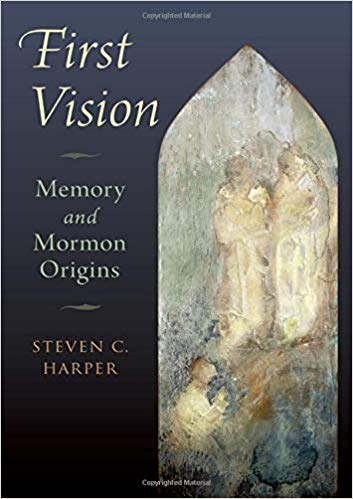
First Vision: Memory and Mormon Origins by Steven C. Harper is the latest entry into the fascinating scholarship focused around what members of The Church of Jesus Christ of Latter-day Saints refer to as Joseph Smith’s First Vision. However, as discussed by Harper in this latest volume, the First Vision wasn’t always styled as such. Nor did the young boy prophet’s theophany always occupy its present prominent place in the faith’s founding narrative.
Dr. Harper is not a newcomer to his subject and has published and presented on the First Vision before in a number of Latter-day Saint scholarly venues.[1] He is comfortable with the scholarship and historiography of his subject, and is able to present his research extremely clearly to his readers as a result. This volume:
charts substantial…new territory. It aims the light of memory studies, amassed over the past century, at Joseph Smith’s narratives…and the rich historical narrative surrounding their compositions. In a way, this book is a travel narrative – the travel of memory through time – telling the odyssey of Smith’s vision from its obscure origins to its current situation as the genesis of The Church of Jesus Christ of Latter-day Saints.[2]
As mentioned, Harper is an experienced scholar and clear communicator, and his writing reflects it. The book’s twenty-nine chapters average only about nine pages each; the short length makes them feel almost like class lectures. The style makes the book equally accessible to both lay readers and experienced scholars of the subject and easy-to-read in one sitting (as I largely did) or in several reading sessions.
Most readers are likely unfamiliar with the field of memory or memory studies, if they “think about it at all.”[3] Anticipating this, Harper provides scholarship and references to important literature in that field throughout, ensuring readers are provided with a good primer on the subject as they read.
This book was not written to determine the truthfulness of one First Vision account over another. As Harper indicates, “[t]he historian’s tools are unfit for the task of determining the veracity of Smith’s first vision; however, they are well suited to evaluate the culture of his vision memories.”[4] Instead, the goal of the book is to “explain how [Joseph Smith] remembered his first vision, how others have remembered it, and what difference those memories have made over time.”[5]
Harper does this well, moving through the breadth of Latter-day Saint history, spending chapters discussing each of the primary accounts of Joseph’s First Vision. Readers will find the chapters he dedicates to each of Joseph’s accounts useful and insightful. For instance, he discusses some of the circumstances around Joseph’s 1832 account, and why Joseph may have consolidated his divine experience in a “socially safe” way, which he would ultimately find unsatisfying.[6] It is thought-provoking discussion, and Harper’s analysis of the circumstances around Joseph’s other accounts is similarly enlightening.
Harper then moves on to the reception history, discussing publications such as Orson Pratt’s 1840 A[n] Interesting Account of Several Remarkable Visions. Most fascinating for me, moving into the early twentieth century, was his discussion of President Joseph F. Smith’s work to emphasize the First Vision to the Saints in the wake of the Reed Smoot hearings and continued troubles both within and without the Church over polygamy.[7] Building on work earlier in the book, Harper shows how Joseph F. brought “a persecuted past to bear on the persecuted present”[8] and how his “selection, relation, and repetition of his uncle’s first vision helped [the saints] navigate their way to a new narrative, one in which plural marriage could be relinquished without eroding faith in revelations received by prophets past or present.”[9]
The history carries forward, as Harper discusses challenges that the First Vision has faced throughout the twentieth and twenty-first centuries, as detractors have challenged the vision’s reality. Harper writes with an even hand throughout this discussion, as he deals with arguments from both qualified and unqualified challengers and demonstrates how the arguments have led to a flowering of scholarship in this subfield of Latter-day Saint history.[10]
Steven C. Harper has produced some fascinating and excellently researched scholarship here, and we highly recommend the book for the shelves of lay readers and experienced scholars alike.
[1] See, for instance, Steven C. Harper, Joseph Smith’s First Vision: A Guide to the Historical Accounts (Salt Lake City: Deseret Book, 2012) and Samuel Alonzo Dodge and Steven Craig Harper, Exploring the First Vision (Provo, UT: Religious Studies Center, Brigham Young University, 2012).
[2] Steven C. Harper, First Vision: Memory and Mormon Origins (New York City: Oxford University Press, 2019), 2.
[3] Harper, First Vision, 2.
[4] Harper, First Vision, 3.
[5] Harper, First Vision, 4.
[6] Harper, First Vision, 27.
[7] See chapter 18, “The Joseph (F.) Story”.
[8] Harper, First Vision, 131.
[9] Harper, First Vision, 137.
[10] See chapter 20, “The Objective Reality of the First Vision is Questioned”, as well as “Part III: Contested Memory” (chapters. 22-28) of the book for this valuable discussion.
 Jared Riddick is a graduate student at the University of North Texas, pursuing a Masters in Library Science. He previously graduated from Brigham Young University-Idaho with a Bachelor of Arts in History Education. He is currently the archivist for Book of Mormon Central, based in Springville, UT. His areas of academic interest include the Book of Mormon and the American Civil War.
Jared Riddick is a graduate student at the University of North Texas, pursuing a Masters in Library Science. He previously graduated from Brigham Young University-Idaho with a Bachelor of Arts in History Education. He is currently the archivist for Book of Mormon Central, based in Springville, UT. His areas of academic interest include the Book of Mormon and the American Civil War.
The post Book Review – First Vision: Memory and Mormon Origins appeared first on FairMormon.
Continue reading at the original source →



